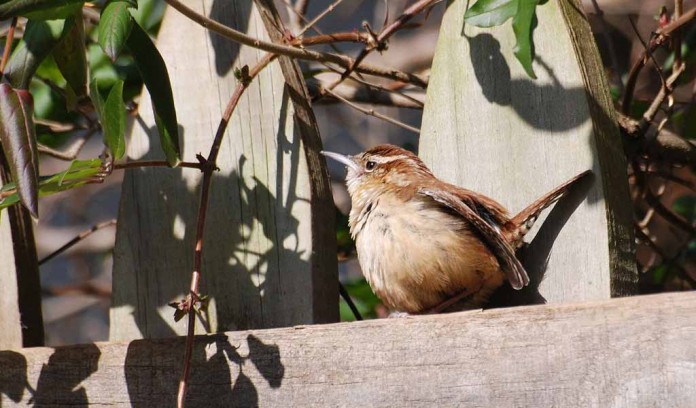
Since the beginning of March, dawn’s first rays of sunlight have been accompanied by loud, ringing, musical whistles.
It’s the voice of a male Carolina wren, and it’s a reliable harbinger of spring.
Singing songbirds
Often the sound is a series of triplets – “Tea kettle! Tea kettle! Tea kettle!” or “Chirpity, chirpity, chirpity!.”
Though most songbirds begin nesting between mid-April to early May, Carolina wrens like to get a head start. By beginning early, they can raise as many as three broods before the end of the summer.
Carolina wrens measure about 5.5 inches long, and compared to the smaller, mousy brown, migratory house wrens that will return in early May, they are handsome — chestnut above, cinnamon below, with a prominent white eye stripe.
They spend most of their time in dense vegetation and are more often heard than seen. But they are common around homes and commonly explore sheds, barns and open garages.
Unusual nest sites
Though classified as cavity-nesters, Carolina wrens usually forsake tree cavities and nest boxes in favor of more unusual nest sites. In more than 30 years, I’ve never found a Carolina wren nest in a traditional bluebird style nest box.
Over the years, I’ve found their nests in mailboxes, cans of nails, empty cardboard boxes, old boots, hanging plants and clothes pin bags. A few years ago they used a one-gallon plastic bucket hanging from a hook on the back porch. Covered from above by the porch roof, it was completely protected from the weather.
Just this week I found the first two Carolina wren nests of the season on either side of a shared wall separating two outside sheds. Though the nests were just inches apart, the wall served as a visual barrier that kept the pairs from squabbling.
First eggs of season
The female Carolina wren usually lays her first egg in mid-March, several weeks before I find the first bluebird eggs of the season.
The nest is loosely constructed and large enough to fill the selected space. Materials may include twigs, grass, strips of barks, dead leaves, moss, hair, feathers, and sometimes even bits of paper, plastic, string, and shed snakeskins.
Building the nest
Typically the nest is domed with an entrance on the side. Both sexes help build the nest, but the male does most of the work. That seems fair because only the female incubates the four or five eggs for about 14 days.
Male feeds the female
Meanwhile, the male defends the territory, which may range from two to ten acres, and brings food to the nest for his mate.
Carolina wrens prefer live food and are great to have around the garden. They eat a variety of insects, caterpillars and egg cases. When I offer mealworms, they gobble them up, and though their decurved bill is adapted for handling live prey, they also happily eat suet, sunflower kernels and shelled nuts.
The cavity
Though Carolina wrens eschew traditional nest boxes, they are easily coaxed into a simple box that takes advantage of this wren’s loose definition of a cavity.
Bob Orthwien, a birder from Columbus, Ohio, came up with this design years ago, and I’ve been using it ever since. The Orthwein Carolina wren box can be made with any type of wood except treated lumber. A one by four pine board, half-inch exterior plywood or suitably sized scrap lumber works well.
Size is not important
Size is not critical because wrens fill the space available, but the interior dimensions should be no smaller than six inches wide by four inches deep by six inches high. The front is a piece of wood half the height of the sides, so the entrance to the box is a wide slot on the top half of the front. The best place to hang a Carolina wren box is “up and under.”
Predators
Boxes placed under a porch roof, deck or in outdoor sheds offer excellent protection from wind and rain and are almost irresistible. And though Carolina wrens will use boxes placed close to the ground, I prefer to hang them five to eight feet above the ground. Boxes near ground level suffer higher rates of predation. A nest box should never become a predator feeder.













Scott Thank you for such a well written article!And I also have many boxes on my property and never had a Carolina wren nest in one. I have had them nest in my hanging flower baskets which I didn’t mind at all because I really enjoy them now if I can only get rid of the house wrens that cause a lot of disruption on my property I would be thrilled!
I enjoyed reading your blog. I thought I’d stop in to let you know I have a Carolina wren nesting in my bluebird box, here in my Texas backyard. They built a nest on our back porch (as they did last season) but a neighborhood cat destroyed it. A couple of weeks later I found them checking out the bluebird box along with some black-capped chickadees. Today they are busy feeding their newborns. While I was writing this one of the chickadees also came to the box, but I think the wrens have been there the whole time. I was surprised to find them there.